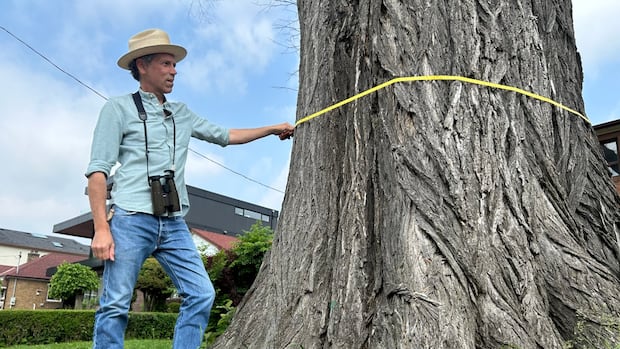[
One of the largest old elm trees in Toronto — possibly in all of southern Ontario — is on its last legs.
But as the city finalizes plans to take down the Barton Street landmark next week, a University of Toronto tree expert is determined to ensure it will live again.
Eric Davies, a forestry ecologist at the University of Toronto, visited the tree earlier this week to record its size and gather its seeds, which will be used to re-grow a copy of the tree in the future as part of the city’s Tree Seed Diversity Program (TSDP). He and his students measured the trunk’s height at 40 metres and its circumference at 5.5 metres.
“It’s sad,” he said of the tree’s fate. “Each one that comes down, you want to do it some kind of justice by improving our ability to maintain Toronto’s trees and forests.”
Residents of the Seaton Village neighbourhood, in the Christie and Bloor streets area, noticed earlier this year that the old American elm remained barren this spring, while much younger nearby trees were growing leaves.
Thirteen-year-old Ethan Tantram, who passes the tree every day on his way to school, said he and his father noticed this spring that the tree seemed ill.
“It’s heartbreaking,” he said this week. “It’s a big thing in our community.”
Unclear what’s killing the tree
The teen used his drone to get a closer look at the tree’s branches and his father later called the city to report the tree wasn’t doing well.
City staff said an inspector determined during a May 30 visit that the tree was dying and posed a danger to the public.

City spokesperson Shane Gerard told CBC Toronto in an email the city has tried to determine exactly what’s killing the tree, but lab results have been inconclusive.
“The tree was observed with a thinning crown and yellowing leaves in late summer 2024,” his email reads. “Removing the tree will prevent it from becoming a hazard, as dead branches are more prone to breakage.”
Davies, who’s recognized by the city as a seed gatherer for the seed diversity program, says he’ll be on hand Tuesday when the tree is brought down.
“This is one of the nicest remaining elms in Toronto (and) probably has a high quality gene stock to it,” he said. “Each one is not only important ecologically but culturally.”

Local artist Jode Roberts, who lives within sight of the tree, agreed it’s meant a lot to the community.
Last year, he used old photos of the neighbourhood from the city archives to peg the tree’s age at at more than 100 years.
He then fashioned a heritage plaque explaining the tree’s significance and attached it to a utility pole next to the tree.

“There’s a profound sadness when something like this disappears,” he told CBC Toronto. “It survived Dutch elm disease and the development of the city around it. So sure — let’s take its babies and see if we can make more majestic elms.”
Native trees vastly outnumbered, says researcher
Once Davies has gathered the elm’s seeds, they’ll go into the TSDP, which will distribute them to one of several participating nurseries in the Greater Toronto Area. Once they’ve matured, in four to seven years, they’ll be planted in one of the city’s 80-odd parks and ravines — one that’s been identified as a good fit for a new elm tree.
Davies and a team of U of T students are spending the summer mapping the city’s largest and oldest native tree species. He says those native trees are vastly outnumbered in Toronto by invasive species, and he hopes his map will allow the city to aid in their regeneration.
Each tree that’s mapped is measured and its seeds collected, he said. Those seeds will then be passed on to the TSDP for regrowth.
One of Davies’ summer students is Sam Sedgwick, who’s studying toward a master’s degree in forest conservation at U of T.
He called the Barton Street elm the most impressive he’s seen so far.
“With the presence of Dutch elm disease, we’ve lost pretty much every large elm in the city, so the fact this one is still here really speaks to its resilience,” he said. “We really want to preserve those genetics as much as we can.”
Sedgwick helped take measurements of the elm earlier this week. He noted the tree is more than five metres in circumference, 40 metres high and that its canopy covers five houses on Barton Street.
“That’s a lot of air conditioning,” he said.
